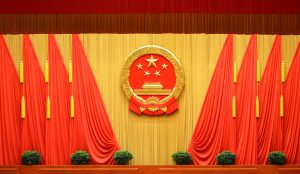China’s “Two Sessions” (the annual meetings of the National People’s Congress and the Chinese People’s Political Consultative Conference) closed on Monday in Beijing. The Two Sessions featured two important announcements regarding China’s economy: a 5 percent GDP growth goal for 2024, and a deficit rate of 3 percent with the issuing of 1 trillion yuan national bond. Notably, President Xi Jinping’s policy papers centered around ensuring “stability” rather than pursuing “progress.”
The GDP growth goal, despite being on par with its past years’ sluggish growth, remains challenging. The Chinese economy has reached a historical inflection point, triggered by the implosion of the real estate sector, high youth unemployment, COVID-19, and a decrease in export volume exacerbated by decoupling with the West. Xi’s top-down leadership style, which rewards loyalty and focuses on tighter control, has rebalanced the economy from market-based to state-planned on the spectrum.
The 5 percent goal is no easy task given the continued global pandemic recovery, supply chain disruptions, trade tensions, and military conflicts around the world. As a comparison, China’s 2023 growth figure of 5 percent, though likely inflated, contrasts with the OECD GDP growth average of 1.6 percent, which dropped from 2.9 percent in 2022.
The deficit rate is set to be 3 percent, in line with last year’s figure. The government announced the issuance of 1 trillion yuan in special national bonds. The main goal is to increase the leverage of the central government to decrease the burden and risk of regional government deficits. According to local sources, some Chinese regional governments are facing high pressure in paying salaries and investment bonds. Local hidden debts continue to pile up in forms such as borrowings made by state-owned enterprises. Recent central government borrowing has mostly gone to repay local debt and disaster relief.
The Two Sessions also indicated a sharper focus on developing critical sectors, especially biomedicine, nanotechnology, and artificial intelligence. Media reports highlighted successful cases of upgrading the manufacturing sector through automation. The focus on using technology to enhance people’s quality of life indicates the domestic orientation of state planning.
The central government recently sought to promote home purchases to salvage the real estate sector by lowering interest rates and lifting purchase restrictions, which has yet to lead to an effective recovery in the housing market. Financial regulations have become more stringent for public companies and the stock market, and practitioners face limitations for compensation as well as trading options. Based on the status quo of China’s economic and political situations, this time we are witnessing a decline that the government cannot simply overturn in the short run through policy simulations.
It has long been understood by the top Chinese leadership that China’s double-digit economic growth would face an inflection point somewhere in the 2020s. As early as the 2010s, China focused on driving the three main components of GDP growth: investment, consumption, and exports. These so-called “three engines” each contributed to different times of the decades-long economic miracle.
Deng Xiaoping, while inheriting a traumatized population and depleted land after years of relentless Communist revolutions, initiated the Reform and Opening in December 1978. The next 20 years were then marked by what Deng called rapid capitalist development, essentially aided by foreign direct investment, a huge population base, technological progress, and the demand for infrastructure and consumption.
China’s economic growth shifted from being driven by investment to being driven by consumption. From 2009 to 2019, investment decreased in proportion while consumption rose. However, it remains low on a relative basis. Consumption accounts for 55 to 64 percent of China’s GDP, while in advanced economies around the world consumption props up 70 to 80 percent of total GDP.
The Chinese government has been keenly aware of this situation and has encouraged public consumption in all tiers of cities in anticipation of the decline in exports, but with limited success. In the future, China will continue to leverage its strengths in newer export areas, such as electric vehicles, in which it is performing well globally.
The government has often found people are not responding to its policies in practice. Xi has tried to instill market confidence in the private sector, but private businesses and their owners everywhere feel immense disadvantages against their growth. China’s economy developed as a “socialist country with Chinese characteristics” – as Deng Xiaoping called it – with state-owned enterprises accounting for 60 percent of China’s market capitalization. Businesses are unwilling to invest, and entrepreneurs are taking a long pause in an era of both economic and political uncertainty.
The collapse of the real estate sector has wiped out huge chunks of household savings over the course of two years, making the government’s policies to encourage personal consumption and investment far from persuasive. Currently, individuals are not consuming, businesses are not investing, and entrepreneurs are not creating. Amid those headwinds, the Two Sessions prioritized stability, the development of critical sectors, and stimulating the economy.

































